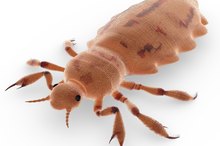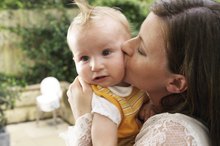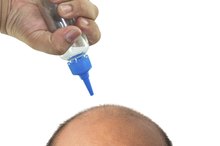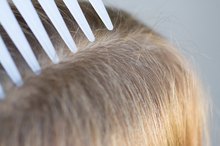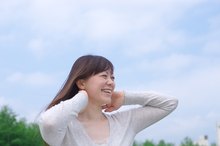What does fact checked mean?
At Healthfully, we strive to deliver objective content that is accurate and up-to-date. Our team periodically reviews articles in order to ensure content quality. The sources cited below consist of evidence from peer-reviewed journals, prominent medical organizations, academic associations, and government data.
The information contained on this site is for informational purposes only, and should not be used as a substitute for the advice of a professional health care provider. Please check with the appropriate physician regarding health questions and concerns. Although we strive to deliver accurate and up-to-date information, no guarantee to that effect is made.
Baby Oil for Head Lice
Although most parents associate baby oil with cradle cap or sweetly scented baby massages, some people see it as a weapon in their head lice-fighting arsenal. In certain cases, baby oil could play a role in dealing with head lice, provided you use it wisely. Talk to your doctor before using baby oil for head lice, especially if you plan to use it on a baby or young child.
The Facts
Head lice, insects that infest the hair of children and adults, consume human blood to stay alive. These parasitic insects cause infestations that vary in severity and often cause itching on the head, neck or shoulders, as well as red bumps arising from a localized reaction to lice saliva. The Centers for Disease Control and Prevention notes that most cases of head lice infestations develop in children between the ages of 3 and 11 years.
Efficacy
How to Treat Head Lice During Pregnancy
Learn More
The value of baby oil as a treatment for head lice is uncertain because of the lack of organized studies. According to Joey Green, author of the book "Joey Green's Amazing Kitchen Cures," baby oil might drown lice, provided you leave it on your hair for the proper amount of time 3. Joan Sawyer, co-founder of the American Head Lice Information and Resource Center and coauthor of the book “Head Lice to Dead Lice,” notes that oil treatments for head lice will only be effective if you follow up the soak with a thorough nit-picking--before rinsing the oil from the hair--and repeat the entire regimen every three to four days for several weeks 4.
Usage
When used to combat head lice, baby oil typically must stay on the hair for multiple hours before you rinse it out. Liberally apply baby oil directly to your hair, suggests Green. Massage the oil thoroughly into your scalp and wrap your head securely with a plastic shower cap, plastic wrap or a plastic shopping bag. Leave your oil-coated, plastic-clad head alone for as least eight hours to ensure that the lice have suffocated, advises Sawyer.
- When used to combat head lice, baby oil typically must stay on the hair for multiple hours before you rinse it out.
Considerations
How to Use Dawn to Kill Lice
Learn More
Deciding whether to use a nonchemical treatment such as baby oil for head lice is a decision you must weigh carefully. In certain cases, such as more severe infestations, your doctor might recommend chemical treatment alone or in combination with natural remedies. Regular combings with a fine-toothed comb--Sawyer recommends a basic, metal nit comb--provide a time-tested way to help remove lice eggs. Additional steps you can take to help control and treat the head lice infestation include avoiding head-to-head contact and washing items, such as:
- bed linens
- combs
- stuffed toys
- hair accessories
- that have come in contact with the affected head
- Deciding whether to use a nonchemical treatment such as baby oil for head lice is a decision you must weigh carefully.
Warning
Talk to your doctor before using baby oil for head lice, particularly for infants and children. When coating hair with baby oil, take special care to keep the oil from eyes, nose and mouth. With mineral oil as its primary ingredient, baby oil could coat mucous membranes and lead to life-threatening respiratory complications if accidentally inhaled, according to the U.S. Product Safety Commission.
- Talk to your doctor before using baby oil for head lice, particularly for infants and children.
- When coating hair with baby oil, take special care to keep the oil from eyes, nose and mouth.
Related Articles
References
- MayoClinic.com: Head Lice Symptoms
- CDC: Head Lice Life Cycle
- “Joey Green’s Amazing Kitchen Cures”; Joey Green; 2002
- “Head Lice to Dead Lice”; Joan Sawyer & Roberta MacPhee; 1999
- InformedHealth.org [Internet]. Cologne, Germany: Institute for Quality and Efficiency in Health Care (IQWiG); 2006-. Head lice: Overview. 2008 Mar 5 [Updated 2018 Dec 13].Available from: https://www.ncbi.nlm.nih.gov/books/NBK279329/
- Rassami W, Soonwera M. Epidemiology of pediculosis capitis among schoolchildren in the eastern area of Bangkok, Thailand. Asian Pac J Trop Biomed. 2012;2(11):901–904. doi:10.1016/S2221-1691(12)60250-0
- van der Wouden JC, Klootwijk T, Le Cleach L, et al. Interventions for treating head lice. Cochrane Database Syst Rev. 2018;2018(5):CD009321. Published 2018 May 22. doi:10.1002/14651858.CD009321.pub2
- Bin Saif GA, Ericson ME, Yosipovitch G. The itchy scalp--scratching for an explanation. Exp Dermatol. 2011;20(12):959–968. doi:10.1111/j.1600-0625.2011.01389.x
- Head lice infestations: A clinical update. Paediatr Child Health. 2004;9(9):647–657. doi:10.1093/pch/9.9.647
- Izri A, Chosidow O. Efficacy of machine laundering to eradicate head lice: recommendations to decontaminate washable clothes, linens, and fomites. Clin Infect Dis. 2006;42(2):e9–e10. doi:10.1086/499105
- Değerli S, Malatyalı E, Mumcuoğlu KY. Head lice prevalence and associated factors in two boarding schools in Sivas. Turkiye Parazitol Derg. 2013;37(1):32–35. doi:10.5152/tpd.2013.08
- Greive KA, Barnes TM. In vitro comparison of four treatments which discourage infestation by head lice. Parasitol Res. 2012;110(5):1695–1699. doi:10.1007/s00436-011-2687-7
- Devore CD, Schutze GE. Head lice. Pediatrics. 2015;135(5):e1355-65.
- Devore CD, Schutze GE; Council on School Health and Committee on Infectious Diseases, American Academy of Pediatrics. Head lice. Pediatrics. 2015 May;135(5):e1355-65. doi:10.1542/peds.2015-0746
Resources
Writer Bio
Regan Hennessy has been writing professionally for 11 years. A copywriter and certified teacher, Hennessy specializes in the areas of parenting, health, education, agriculture and personal finance. She has produced content for various websites and graduated from Lycoming College with a Bachelor of Arts in English.
